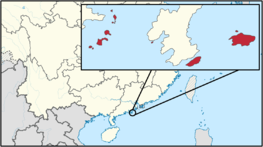Empire of China (Wuzhou Island)
Empire of China 中華帝國 Zhōnghuá | |||||||||||||||
|---|---|---|---|---|---|---|---|---|---|---|---|---|---|---|---|
| Anthem: (中國的帝國國歌) National Anthem of the Empire of China | |||||||||||||||
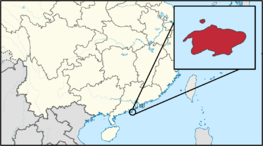 | |||||||||||||||
| Capital | New Peking | ||||||||||||||
| Official languages | Chinese, English | ||||||||||||||
| Government | Single-party state under constitutional monarchy | ||||||||||||||
• Emperor | Liu-kuang (2014) | ||||||||||||||
• Prime Minister | Wong Bao-kong (12–16 July 2014) | ||||||||||||||
| Legislature | National Yuan (Empire of China) | ||||||||||||||
| Establishment | 12 December 1915 Disestablished 22 March 1916 Re-established 25 June 2014 Empire of Chukou 16 July 2014 | ||||||||||||||
| Currency | Empire of China Yuan | ||||||||||||||
| |||||||||||||||
| This article is part of a series on the |
| History of Beiwan |
|---|
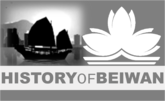 |
| Timeline |
Wuzhou Island (浯嶼), was commonly known as Wuzhou (梧州), officially the Empire of China (中華帝國), was a micronation in East Asia. The Empire of China, was based in mainland China, in 2014 it governed the island of Wuzhou, which made up over 99% of its territory. New Peking was the seat of government and the country's capital city. The empire was a Single-party state under constitutional monarchy led by the Chinese Imperial Rule Assistance Association.
History
Empire of China (1915–16)
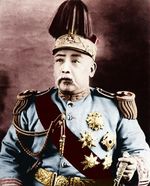
The Empire of China was a short-lived attempt by statesman based in mainland China and general Yuan Shikai from late 1915 to early 1916 to reinstate monarchy in China, with himself as the Hongxian Emperor. The attempt was ultimately a failure, but it set back the Chinese republican cause by many years and fractured China into a period of conflict between various local warlords.
Re-establishment of the Empire of China
Emperor Liu-kuang has claimed that his government has authority over Wuzhou Island by informing the Government of the People's Republic of China about the micronation's claim of independence and declared it the successor of Yuan Shikai's Empire of China. The date of the proclamation of the new state entity is 25 June 2014. By the constitution of the Empire of China, it is a single-party state under constitutional monarchy and the successor of the empire founded by Yuan Shikai. This claim is denied by the Chinese Authority.
Government and politics
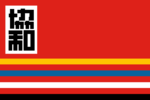
The Empire of China was a constitutional monarchy where the power of the Emperor is very limited. As a ceremonial figurehead, he was defined by the constitution as "the symbol of the state and of the unity of the people." Power was held chiefly by the Prime Minister and other elected members of the National Yuan, while sovereignty is vested in the people. Wuzhou's legislative organ was the National Yuan, a bicameral parliament. The Yuan consisted of a House of Representatives, elected by popular vote every four years or when dissolved, and a House of Councillors, whose popularly elected members serve six-year terms. The Yuan was dominated by the Imperial Rule Assistance Association. The Prime Minister was the head of government and was appointed by the Emperor after being designated by the Yuan from among its members. The Prime Minister was the head of the Cabinet, and he did appoints and dismisses the Ministers of State. Although the Prime Minister was formally appointed by the Emperor, the Constitution of the Empire of China explicitly requires the Emperor to appoint whoever was designated by the Yuan.


